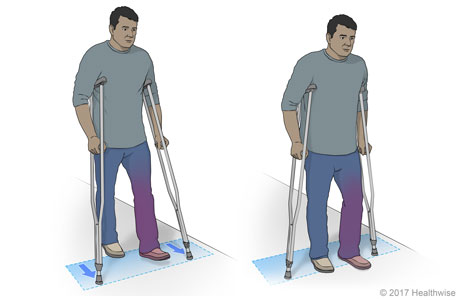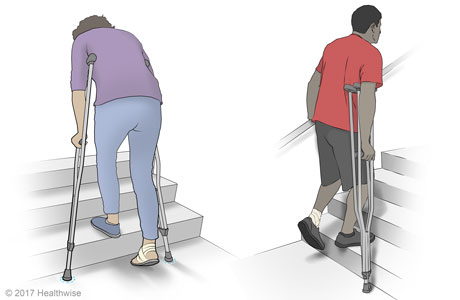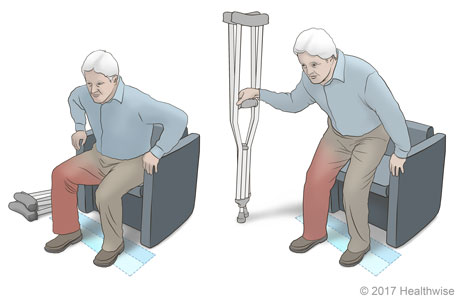Our Health Library information does not replace the advice of a doctor. Please be advised that this information is made available to assist our patients to learn more about their health. Our providers may not see and/or treat all topics found herein. Crutches can help you walk when you have an injured hip, leg, knee, ankle, or foot. Your doctor will tell you how much weight—if any—you can put on your leg. Be sure your crutches fit you. When you stand up in your normal posture, there should be space for two or three fingers between the top of the crutch and your armpit. When you let your hands hang down, the hand grips should be at your wrists. When you put your hands on the hand grips, your elbows should be slightly bent. A walking aid—a walker, crutches, or a cane—helps if you have limited strength, range of motion, joint stability, coordination, or endurance. Using a walking aid can help you be more stable, safe, and independent in your daily activities. It can also reduce the stress on a painful joint or limb. Here are some ideas to make using your walking aid easier and safer. They can be unpredictable and get in your path when you least expect it. This helps prevent slipping. You can buy replacement tips from medical supply stores and drugstores. Ice tips are also available to use outdoors in winter weather. Be careful with wet floors and snowy or icy driveways. In bad weather, be especially careful on curbs and steps. Put one or both hands on the surface you're sitting on or on the arms of the chair as you sit down or stand up. If it is okay, have them show you how to do it correctly. If you're able to put weight on your weak or injured leg, use the crutches for added support. (Constant pressure against your underarms can cause numbness.) When you're confident using the crutches, you can move the crutches and your injured leg at the same time. Then push straight down on the crutches as you step past the crutches with your strong leg, as you would in normal walking. Use ramps and elevators when you can. (Constant pressure against your underarms can cause numbness.) When you're confident using the crutches, you can move the crutches and your injured leg at the same time. Then push straight down on the crutches as you step past the crutches with your strong leg, as you would in normal walking. Try this first with another person nearby to steady you if needed. And remember "up with the good, down with the bad" to help you lead with the correct leg. To go up, step up with your stronger leg. Then bring the crutches and your weak or injured leg to the upper step. To go down, put your crutches and your weak or injured leg on the lower step. Then bring your stronger leg down to the lower step. Put both crutches under the arm opposite the handrail. Use the hand opposite the handrail to hold both crutches by the handgrips. Hold on to the handrail as you go up or down. To go up, step up with your stronger leg. Then bring the crutches and your weak or injured leg to the upper step. To go down, put your crutches and your weak or injured leg on the lower step. Then bring your stronger leg down to the lower step. Use one hand to hold both crutches by the handgrips, beside your injured leg. With the other hand, hold on to the seat and slowly lower yourself onto the chair. Lay the crutches on the ground near your chair. If you prop them up, they may fall over. Put your weight on the handgrips of the crutches and on your strong leg to stand up. Current as of: July 24, 2025 Author: Ignite Healthwise, LLC Staff Current as of: July 24, 2025 Author: Ignite Healthwise, LLC Staff Clinical Review Board This information does not replace the advice of a doctor. Ignite Healthwise, LLC disclaims any warranty or liability for your use of this information. Your use of this information means that you agree to the Terms of Use and Privacy Policy. Learn how we develop our content. To learn more about Ignite Healthwise, LLC, visit webmdignite.com. © 2024-2025 Ignite Healthwise, LLC.Topic Contents
Using Crutches
Overview
Being safe
Walking: If you can put weight on your leg

Walking: If you can't put weight on your leg

Going up and down stairs
If the stairs don't have a handrail, stand near the edge of the stairs.

If the stairs have a sturdy handrail, stand near the edge of the stairs.

Sitting down and standing up
To sit, back up to the chair.

To get up from a chair, pick up the crutches and put them in one hand beside your injured leg.

Related Information
Credits
Clinical Review Board
All Ignite Healthwise, LLC education is reviewed by a team that includes physicians, nurses, advanced practitioners, registered dieticians, and other healthcare professionals.
All Ignite Healthwise, LLC education is reviewed by a team that includes physicians, nurses, advanced practitioners, registered dieticians, and other healthcare professionals.
Our Health Library information does not replace the advice of a doctor. Please be advised that this information is made available to assist our patients to learn more about their health. Our providers may not see and/or treat all topics found herein. Current as of: July 24, 2025 Author: Ignite Healthwise, LLC Staff Clinical Review BoardUsing Crutches
All Ignite Healthwise, LLC education is reviewed by a team that includes physicians, nurses, advanced practitioners, registered dieticians, and other healthcare professionals.



